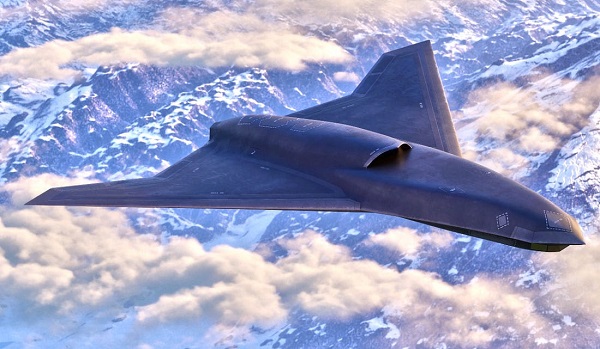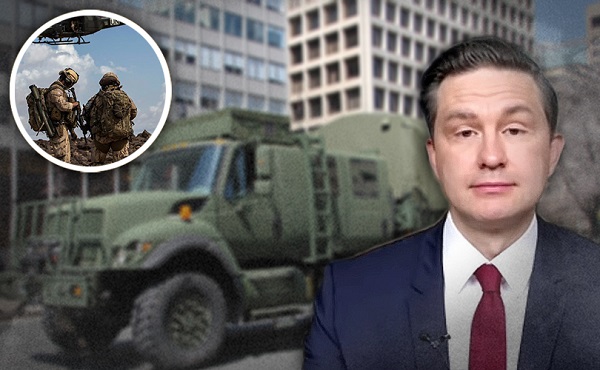armed forces
Secretive Lockheed Martin Skunk Works reveals latest high-tech military drone

 THE MAKICHUK REPORT
THE MAKICHUK REPORT
Unmanned Vectis to ride shotgun with next-gen fighters
When Lockheed Martin’s super secret Skunk Works© advanced development arm unveils a new project, the aviation world stops and listens.
As always, it is very hush-hush, and, quite often, groundbreaking.
This week’s announcement didn’t disappoint.
It’s called “Vectis” — a stealthy autonomous drone that Lockheed intends to fly by the end of 2027.
As with most Skunk Works projects, officials declined to comment on certain aspects of the aircraft’s design, such as its engine or top speed, though it was noted that Lockheed’s analysis “doesn’t point toward supersonic [speeds]” as a requirement.
What do we know about it, aside from it’s very cool, futuristic design?
The first Vectis prototype is currently “in progress,” and is envisioned as a large “Category 5” reusable drone designed to be customizable to match shifts in the threat environment, said OJ Sanchez, Skunk Works’s vice president and general manager.
“Vectis provides best-in-class survivability at the CCA [Collaborative Combat Aircraft] price point,” Sanchez told reporters ahead of the Air Force Association’s Air Space and Cyber conference in Washington, D.C. “Prototype parts are ordered, the team is in work, and we intend to fly in the next two years.”
According to Breaking Defense, Lockheed sees the range, endurance and flexibility of Vectis’s design as key to its appeal.
It is being developed for the US and international markets based on feedback from multiple customers about the future battlefield.
One has to only look at the Russia-Ukraine conflict, to see that things have changed.
Vectis can carry out mission sets ranging from air-to-air, air-to-ground and ISR, and has an open systems architecture allowing it to interface with platforms and mission systems not built by Lockheed Martin, Breaking Defense, reported.
Certain aspects of the drone — such as which payloads it can carry, or whether it is optimized for regular operations or used less frequently on deployments — can be fine-tuned to meet a customer’s specific requirements.
For instance, “we will have built into it the ability for it to be a daily flyer, reliably work alongside its crew teammates, to be able to integrate into operations for training, as well as for deployment,” Sanchez said.
“At the same time, if the requirement is ease of storage and ease of assembly, it’s absolutely built into the design. … That’s where we’ll work closely to listen with any individual customers and go from there on their operations choice, but the flexibility is built in.”
With the lessons of Ukraine in mind, Vectis is designed to be maintainable in a deployed environment, with a simple design made of “and durable, reliable materials” and easy access to the aircraft’s internal systems if repairs need to be made.
While it has not flown, Lockheed has conducted operational analysis and simulations that paired the drone with the F-22 and F-35, with Sanchez noting that its low-observable signature and communications gear are “compatible” with fifth- and sixth-generation aircraft.
It was also informed by previous experience designing tailless aircraft like the X-44 MANTA, Lockheed’s sixth-generation fighter prototype for the Air Force’s Next Generational Air Dominance program, Sanchez said.
“We’re building in that kind of autonomy, that flexible autonomy, if you will, so that we can work with more countries, more partners, to really listen to what their needs are,” he said.
“That flexibility has been demonstrated through multiple demonstrations. Now we’ll go out and build it, and we’ll work to prove in the open air.”
In the U.S. military’s parlance, Group 5 uncrewed aerial systems are the largest and most capable, covering anything pilotless with a maximum takeoff weight of 1,320 pounds or more, and that can fly at altitudes of 18,000 feet or higher.
When asked, Sanchez declined to offer any hard dimensions or other specifications for Vectis. He did say it was smaller than a Lockheed Martin F-16 fighter, but larger than one of the company’s Common Multi-Mission Truck (CMMT, pronounced ‘comet’) missile-like drones, which is a very broad size range.
According to experts at TWZ.com, renderings of Vectis from Skunk Works show a tailless drone with a lambda wing planform and a top-mounted air intake.
There is a pronounced chine line around the forward end of the fuselage and a shovel-like shape to the nose, as well as various conformal antennas and/or sensor apertures, all of which are indicative of low-observable (stealthy) design considerations.
A short promotional video also includes a cutaway view showing an S-shaped duct behind the air intake and exhaust shrouding, features that offer further radar cross-section and infrared signature reducing benefits.
Vectis’ core planform is interestingly reminiscent, in some broad strokes, of a rendering of a stealthy aerial refueling tanker concept Skunk Works first showed publicly last year.
That aircraft had a much larger design, in line with its intended mission, with large clipped wings that had some lambda-wing attributes, as well as small outwardly-canted twin vertical tails.
There has been something of an uptick in recent years in new crewed and uncrewed tactical aircraft designs with lambda or at least lambda-like planforms.
This includes one of the several air combat drone designs that emerged around a massive military parade in China earlier this month, as well as one of the two Chinese next-generation crewed combat jets that broke cover in December 2024.
Vectis also has “endurance ranges compatible with Indo-Pacific, European, and CENTCOM [U.S. Central Command] theaters,” according to a Lockheed Martin press release.
What munitions and other payloads Vectis might be able to carry is unclear. Skunk Works’ Sanchez mentioned “reusable or flexible payloads,” but did not elaborate.
The promotional video shows a vignette in which the drones, operating together with an F-22, use unspecified sensors to spot and track aerial threats before being ordered to fire air-to-air missiles, presumably from internal bays, at those targets.
Electronic warfare suites and signal relay packages might also be among the payload options for Vectis drones.
Sanchez did not provide any hard cost metrics for Vectis. The Air Force has said in the past that it is aiming for a unit cost roughly in the US$20 million range for drones being developed under the first phase, or Increment 1, of its CCA program.
In discussing how Vectis could be adaptable to multiple U.S. and foreign operator requirements, Sanchez also spoke in more detail about the drone’s current dependence on traditional runways, as well as its ability to operate from more austere locations.
“Our analysis aligns with the U.S. Air Force, that runway accessibility is incredibly important in every theatre, particularly in INDOPACOM [the U.S. Indo-Pacific Command area of responsibility]. So we’re very intentional about the flexibility that this system would enable in the theaters of interest,” Sanchez explained.
“And so the amount of runways that will be available, the amount of flexibility to implement, whether it be an Agile Combat Employment approach, or a hub and spoke for other countries, depending on how it is, Vectis will be very capable in those spaces.”
Exactly how Skunk Works envisions the Vectis will handle counter-drone weapons, such as Israel’s Iron Dome, Iron Beam, or David’s Sling, remains uncertain.
THE MAKICHUK REPORT is free today.
You can tell THE MAKICHUK REPORT that their writing is valuable by pledging a future subscription.
You won’t be charged unless they enable payments.
armed forces
Mark Carney says Canada will give ‘military assistance’ to Ukraine at taxpayer expense

From LifeSiteNews
The prime minister’s office confirmed that Canada would commit to ‘direct and scalable military assistance’ in Ukraine when the war has calmed down.
The Canadian government under Liberal Prime Minister Mark Carney has made a promise for “military assistance” to Ukraine once a ceasefire is in place.
Carney made the comments after attending a recent virtual meeting for the “Coalition of the Willing” pro-Ukraine nations.
Late last week, Carney’s office confirmed that Canada would commit to “direct and scalable military assistance” in Ukraine when the war has calmed down.
At the “Coalition of the Willing” meeting, French President Emmanuel Macron said 26 allies of Ukraine promised to deploy their armed forces via land, sea, or air to the nation as a “reassurance force,” but not until the war with Russia is officially over.
Placing Canadian troops in Ukraine would come at a huge cost to Canadian taxpayers, who are already dealing with high inflation and high taxes.
The reality of the Ukraine war is grim. To date, it is estimated to have cost the lives of more than 1.5 million people.
Retired Col. Douglas Macgregor accused Western powers of sustaining a war built on illusion, not diplomacy.
From black-market weapons ending up with cartels to unchecked government corruption, Macgregor warned that U.S. aid is fueling chaos and not peace.
Critics of Canada’s support for Ukraine, such as from People’s Party of Canada (PPC) leader Maxime Bernier, have said Canada should not be involved in the Ukraine-Russia conflict.
He noted how politicians, including Carney and Canadian Conservative Party leader Pierre Poilievre, “standing” with the nation in an escalating war realistically means they support Ukraine’s eventual “destruction.”
armed forces
Poilievre vows to rebuild Canada’s military, replace ‘woke culture’ with ‘warrior culture’

From LifeSiteNews
The Conservative Party leader has pledged to increase military spending and re-emphasize ‘bravery, honour, patriotism and strength.’
Conservative Party leader Pierre Poilievre has promised to rebuild Canada’s military after years of “ideological extremism” under the Liberals.
In an August 16 open letter to serving Canadian Armed Forces (CAF) members at CFB Wainwright, Poilievre made 22 commitments to restore Canada’s military while ending the “woke culture” promoted by the Liberal government.
“After years of Liberal neglect, underfunding, and ideological extremism, our military is hollowed out. The world is becoming more dangerous, and our enemies are watching,” Poilievre declared. “It’s time we send them a message: Canada is back.”
“Conservatives believe now is the time to make the largest rebuild of our military in a generation, beginning in the North and extending across our land,” he continued.
Poilievre’s plan included increased military spending, replenishing Canada’s weapons which were donated to Ukraine, and boosting support for military members and their families. It also outlined support systems for veterans.
He further promised to “replace the woke culture with a warrior culture.”
“No more DEl. No more weird political agendas,” Poilievre declared. “The military is a fighting force, not an instrument of social engineering. Bravery, honour, patriotism and strength are its pillars.”
“To serve is to sacrifice,” he continued. “But service should not mean neglect. I will fight for you to once again be respected, equipped, and empowered. We will put our country first, and that begins with giving our Armed Forces the tools and culture of victory.”
The Canadian military is currently suffering from recruitment shortages, which many experts have revealed is a result of embracing and pushing the LGBT ideology within the CAF.
In 2023, officials admitted that the nation’s military is shrinking to dangerously low numbers as Liberals continue to push the LGBT agenda on Canadian soldiers. In addition to low recruitment, the military is struggling to retain soldiers.
As LifeSiteNews previously reported, the military spent Canadians’ tax dollars on polls, guest speakers, presentations, workshops, and LGBT flags. The workshops covered topics including “the gendered nature of security,” while one talk discussed “integrating gender and diversity perspectives.”
In 2021, the defense department revealed that they have two separate committees and eight programs which worked to appoint homosexual advisors to “innovate” religious instruction and gender-neutral uniforms.
In June 2023, Canadian troops in Latvia were forced to purchase their own helmets and food when the Liberal government failed to provide proper supplies. Weeks later, former Prime Minister Justin Trudeau lectured the same troops on “climate change” and disinformation.
A Canadian Armed Force member previously told LifeSiteNews that between the COVID vaccine mandates and pushing the LGBT agenda, Canadian soldiers have lost confidence in the military.
He explained that ideological agendas are driving away new recruits, as the primary source of recruitment for the military is “Saskatchewan farm boys” who want to serve Canada – not radical left-wing ideologues.
“That farm boy looks at the army and with the blue hair and the face, piercings and ideologies and all that stuff,” he said. “And it doesn’t have the same pull because it doesn’t represent the farm boy’s values.”
“This is not the Canada that we signed up to defend. It’s an alien ideology that people don’t resonate with,” he continued. “These are not Canadian values of freedom and democracy. These are cancel culture values of censorship, of authoritarianism, of radical ideologies that are alien to our culture.”
In one such example of how this ideological mandate has impacted soldiers, a commanding officer of the 4th Canadian Division Support Group (CDSG) of the Greater Toronto Area Detachment threatened personnel who dared to throw out tampon dispensers which had been placed in men’s bathrooms as part of the military’s new “inclusion” policy.
-

 Business1 day ago
Business1 day agoCarney’s ‘major projects’ list no cause for celebration
-

 Business1 day ago
Business1 day agoGlobal elites insisting on digital currency to phase out cash
-

 Business1 day ago
Business1 day agoRed tape is killing Canadian housing affordability
-

 Health1 day ago
Health1 day agoMAiD should not be a response to depression
-

 Artificial Intelligence1 day ago
Artificial Intelligence1 day agoUK Police Chief Hails Facial Recognition, Outlines Drone and AI Policing Plans
-

 Business1 day ago
Business1 day agoOttawa’s so-called ‘Clean Fuel Standards’ cause more harm than good
-

 Business1 day ago
Business1 day agoThe Truth Is Buried Under Sechelt’s Unproven Graves
-

 International1 day ago
International1 day agoFrance records more deaths than births for the first time in 80 years








